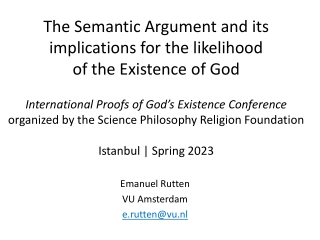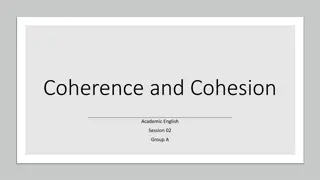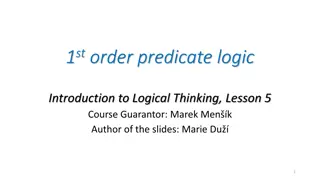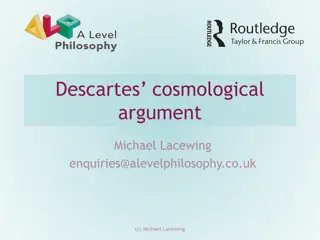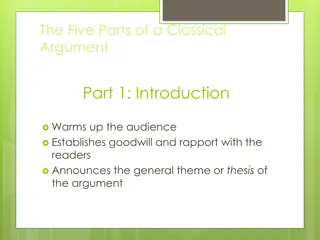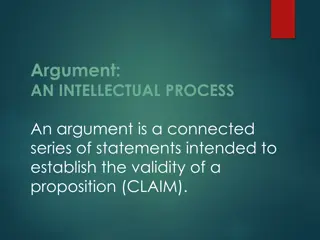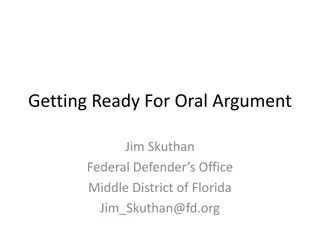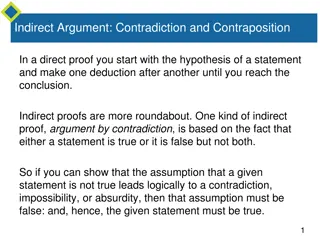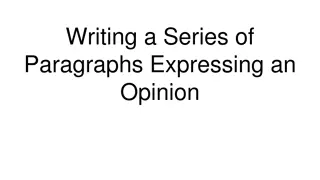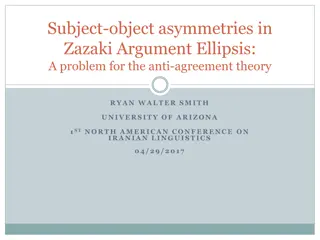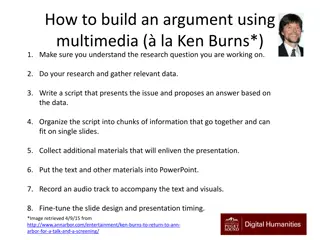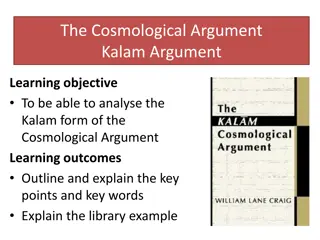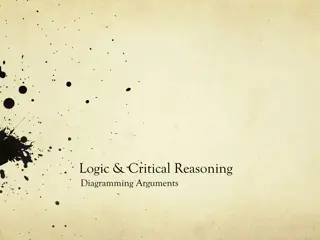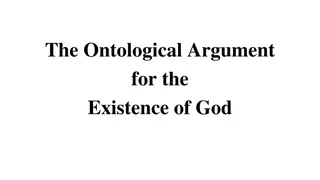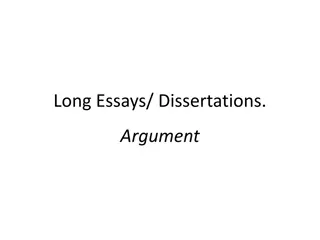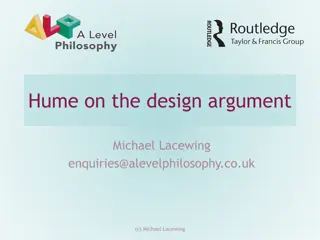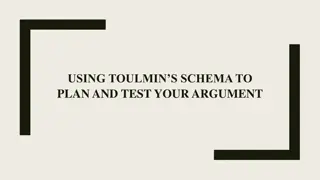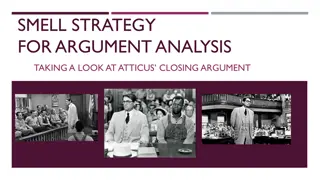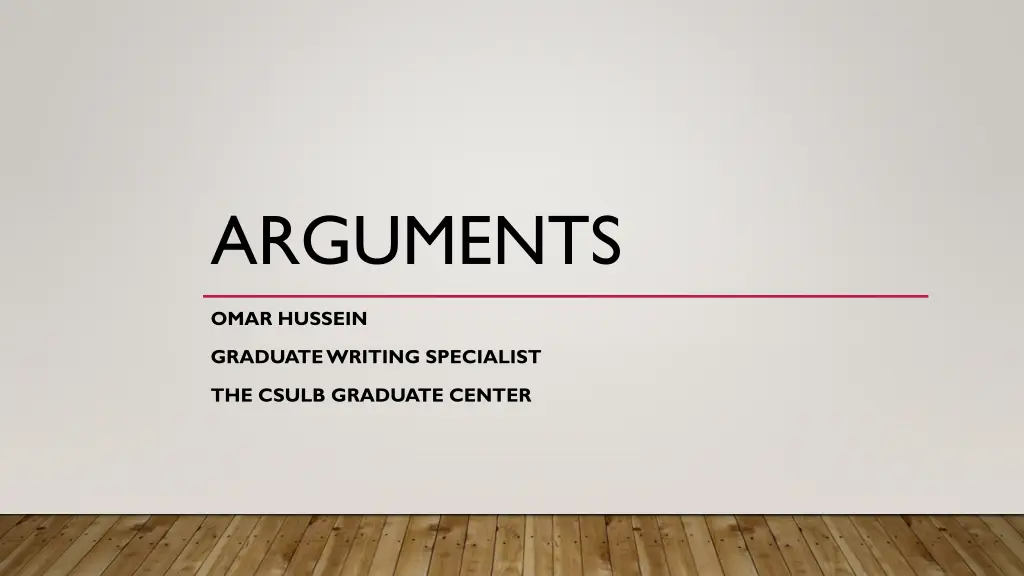
Crafting a Persuasive Argument in Graduate Writing
Learn how to organize your research notes effectively, plan a compelling argument, and consider the reader's perspective in graduate-level writing. Discover tips on convincing your audience and addressing objections to your claims for a successful academic paper.
Download Presentation

Please find below an Image/Link to download the presentation.
The content on the website is provided AS IS for your information and personal use only. It may not be sold, licensed, or shared on other websites without obtaining consent from the author. If you encounter any issues during the download, it is possible that the publisher has removed the file from their server.
You are allowed to download the files provided on this website for personal or commercial use, subject to the condition that they are used lawfully. All files are the property of their respective owners.
The content on the website is provided AS IS for your information and personal use only. It may not be sold, licensed, or shared on other websites without obtaining consent from the author.
E N D
Presentation Transcript
ARGUMENTS OMAR HUSSEIN GRADUATE WRITING SPECIALIST THE CSULB GRADUATE CENTER
PRELIMINARIES Once you ve accumulated a stack of notes, photocopies, and summaries, don t keep piling them up until they spill off your desk (or you lose track of them on your hard drive). It s time to impose some order on what you ve found. The risk, however, is that you just group your data under obvious headings, arrange them into some arbitrary sequence, and start writing. Do that and you re likely to end up with a data dump that says little more than Here are some facts about my topic. You need a more powerful principle of organization, one based not on your data but on the solution to your problem and the logic of its support. That support takes the form of a research argument. Booth, Colomb, &Williams (2008), The Craft of Research, 3rded. The following slides borrow and steal shamelessly from The Craft of Research and other related works by Joseph Williams and company. I note the sources (as I m doing here) but I don t always use proper citation.
PRELIMINARIES (CONTINUED) Arguments are meant to convince readers. They answer the question Why should I believe that? Experienced writers may plan the argument and the paper draft at the same time. Beginners, or anyone struggling with arguments, might need to first plan the argument, then plan (and draft) the paper.
ARGUMENTS: THINKING ABOUT THE READER For any piece of writing, you should always be thinking about the reader. Who is the reader? What does the reader want to know? (i.e., why is the reader reading my paper) Don t think of the reader as your professor (even if your professor is the only person who s actually going to read the paper). Thinking this way is a mistake. Instead, picture an idealized or imaginary reader. For college and grad school, a good imaginary reader might be a classmate of yours (a peer) who shares with you a knowledge of the basic ideas of the field but doesn t know anything about your specific paper topic.
ARGUMENTS: THINKING ABOUT THE READER (CONTINUED) Another (related) way of thinking about the imaginary reader (from the philosopher Jim Pryor): Pretend that your reader is lazy, stupid, and mean. He's lazy in that he doesn't want to figure out what your convoluted sentences are supposed to mean, and he doesn't want to figure out what your argument is, if it's not already obvious. He's stupid, so you have to explain everything you say to him in simple, bite-sized pieces. And he's mean, so he's not going to read your paper charitably. (For example, if something you say admits of more than one interpretation, he's going to assume you meant the less plausible thing.)" Source (Pryor s page is on philosophical writing, but that quote is relevant to academic writing in general).
PLANNING YOUR ARGUMENT: QUESTIONS TO ASK YOURSELF What am I claiming? What reason(s) do I have for believing my claim(s)? What evidence supports those reasons? Do I acknowledge and respond to possible objections? What principle (warrant) makes my reason(s) and evidence relevant to my claim(s)?
CLAIMS + REASONS Claims are based on reasons The emancipation of Russian peasants was an empty gesture (claim) because it did not improve the material quality of their daily lives. (reason) TV violence can have harmful psychological effects on children (claim) because their constant exposure to violent images makes them think that violence is natural. (reason) These reasons, in turn, are supported by evidence.
CLAIMS + REASONS: PRACTICE Which one of these sentences is the (main) claim of the paragraph? Manufacturers increase profits and sales when they create loyal customers who buy their product once and return to buy it a second time without the need for advertising or a high-powered sales force. Customers become loyal when they are satisfied with the quality of service they get on the product when it breaks down, but more importantly with the product s intrinsic quality. Therefore, while manufacturers should focus on both service and product quality, they should emphasize product quality. Source: Wiliams and Colomb (2003), The Craft of Argument (2nd ed.).
CLAIMS + REASONS: PRACTICE -ANSWER Which one of these sentences is the (main) claim of the paragraph? Manufacturers increase profits and sales when they create loyal customers who buy their product once and return to buy it a second time without the need for advertising or a high-powered sales force. Customers become loyal when they are satisfied with the quality of service they get on the product when it breaks down, but more importantly with the product s intrinsic quality. Therefore, while manufacturers should focus on both service and product quality, they should emphasize product quality.
CORE OF AN ARGUMENT CLAIM based on REASONS supported by EVIDENCE Humans are causing global warming (CLAIM) because human activities like energy production and transportation are pumping large quantities of excess CO2 into the atmosphere (REASON), and numerous studies (Anderson et al., 2016; Callendar, 1938; Kramer et al., 2021) demonstrate that excess CO2 traps energy from the sun that would normally be reflected into space, thus warming the planet (EVIDENCE). Arguments sometimes also (1) acknowledge and respond to counterarguments and (2) provide a general principle (warrant) that shows how the reasons and evidence are relevant to the claim.
CLARIFICATION OF TERMS Claim: A sentence that asserts something that can be true or false. The answer to your research question is a type of claim, and so is the solution to a problem. Main claim of a paper (also called a thesis statement ): The sentence (or sentences) that the whole paper supports. Reason: A sentence supporting a claim, main or not. These terms can be confusing, because a reason is also a sub-claim that can be supported by more reasons. For example: TV can have harmful psychological effects on children (main claim) because when they are constantly exposed to violent images, they come to think violence is natural. (sub-claim = reason 1 supporting main claim) Those exposed to lots of such visual entertainment tend to adopt the values of what they see. (sub-claim = reason 2 supporting reason 1) In other words, reasons support main claims, but lower reasons can support higher reasons.
EXAMPLE TV violence can have harmful psychological effects on children (claim) because those exposed to lots of TV tend to adopt the values of what they see. (reason 1 supporting the claim). Constant exposure to violent images makes them unable to distinguish fantasy from reality. (reason 2 supporting, or elaborating on, reason 1). Smith (1997) found that children ages 5 7 who watched more than three hours of violent television a day were 25 percent more likely to say that what they saw on television was really happening. (evidence supporting reason 2). But we can also think of reasons as being sub-claims.
EXAMPLE (ALTERNATE ANALYSIS) TV violence can have harmful psychological effects on children (claim) because those exposed to lots of TV tend to adopt the values of what they see. (reason 1 supporting the claim = sub-claim 1). Constant exposure to violent images makes them unable to distinguish fantasy from reality. (reason 2 supporting reason 1 = sub-claim 2). Smith (1997) found that children ages 5 7 who watched more than three hours of violent television a day were 25 percent more likely to say that what they saw on television was really happening. (evidence supporting reason 2).
EVIDENCE VS. REASONS Evidence is usually considered to be based on the senses, even if indirectly (e.g., facts discovered by observation or experiment), but can also (depending on the field) include logical and mathematical reasoning. Examples of evidence: Case studies, statistics, confirmed facts, expert testimony. In grad school, your evidence will usually be: (1) citations of reputable sources or (2) your own data that you collected, or (3) (in some cases) your own deduction, proofs, or reasoning. We usually have to search for evidence in the world. In contrast, we think up reasons in our own mind. Contrast: What evidence do you base your reason on? (sounds perfectly natural/answerable) What reason do you base your evidence on? (sounds weird/unanswerable)
ACKNOWLEDGING & RESPONDING TO OBJECTIONS (COUNTER-ARGUMENTS) Remember, your imaginary reader is mean : No thoughtful reader will accept your claim based solely on your views: you must also address theirs. Craft of Argument, p. 112 You have to practice figuring out different ways that a reader might object to your argument, then acknowledge and respond to these objections.
EXAMPLE WITH ACKNOWLEDGEMENT + RESPONSE TV violence can have harmful psychological effects on children (claim) because those exposed to lots of TV tend to adopt the values of what they see. (reason 1 supporting the claim = sub-claim 1). Constant exposure to violent images makes them unable to distinguish fantasy from reality. (reason 2 supporting reason 1 = sub-claim 2). Smith (1997) found that children ages 5 7 who watched more than three hours of violent television a day were 25 percent more likely to say that what they saw on television was really happening. (evidence supporting reason 2). Of course, some children who watch more violent entertainment might already be attracted to violence. (acknowledgment) But Jones (1999) found that children with no predisposition to violence were as attracted to violent images as those with a violent history. (response)
FIGURE 1: From The Craft of Research (3rd ed.), p. 113
BUT DONT FOLLOW FIGURE 1 TOO RIGIDLY Claims, reasons, etc. can occur in many different orders. Sometimes you start with the acknowledgement ( While it is commonly argued that ), followed by your response(s) ( This claim is suspect for several reasons . ) and finally your claim. ( For these reasons, I argue that ). You can also sometimes start with evidence ( Each year, 5 million people experience bullying on social media sites . In addition, 30% of internet users . ), followed by the reasons (sub-claims) that this evidence supports ( These numbers show that internet bullying is a major problem ), and then finally your main claim ( Thus, mental health experts must study internet bullying ). You also might need to add explanations or elaborations (e.g., defining terms, giving concrete examples) along the way to help your reader.
DO YOU HAVE A WARRANT? Even when readers agree that a reason is true, they may not see why that reason is relevant to you claim. For example: We should leave (claim) because 2 + 2 = 4 (reason). Presumably everyone will agree that the reason is true. But what does it have to do with the claim? Here s a less wacky example: We are facing significantly higher health care costs in Europe and North America (claim) because global warming is moving the line of extended hard freezes steadily northward. (reason) Again, the connection between claim and reason isn t obvious. What do hard freezes have to do with healthcare costs?
WARRANTS (CONTINUED) This argument We are facing significantly higher health care costs in Europe and North America (claim) because global warming is moving the line of extended hard freezes steadily northward. (reason) needs a warrant: a general principle that shows how the reason supports the claim. Here s one: When an area has fewer hard freezes, it must pay more to combat new diseases carried by subtropical insects no longer killed by those freezes.
WARRANTS (CONTINUED) Here s the argument with the warrant added: When an area has fewer hard freezes, it can expect higher medical costs to cope with diseases carried by subtropical insects that do not survive freezes. (warrant) Europe and North America must thus expect higher health care costs (main claim) because global warming is moving the line of extended hard freezes steadily north. (reason) In the last one hundred years, the line of hard freezes lasting more than two weeks has moved north at the rate of roughly (evidence)
FIGURE 2: From The Craft of Research (3rd ed.), p. 116
BUILDING A COMPLEX ARGUMENT The 5 elements (claim, evidence, reason, acknowledgement + response, warrant) constitute the core of a basic argument. But arguments in research reports are usually more complex. We almost always support a claim with two or more reasons, each of which must be supported by its own evidence and perhaps justified by its own warrant. Since readers think of many alternatives and objections to any complex argument, you ll typically have to respond to several of them. Note: The text on this slide and two following it is plagiarized almost verbatim from The Craft of Research, pp. 116-117.
BUILDING A COMPLEX ARGUMENT (CONTINUED) Moreover, each element of an argument may itself have to be treated as a subclaim, supported by its own argument. Each response to an objection may need reasons and evidence to support it. If your readers doubt the truth of a warrant, you may have to treat it as a subclaim and support it with its own argument, including reasons, evidence, and perhaps even its own warrant with its own acknowledgments and responses. Only the evidence stands alone, but even then you must explain where you got it and maybe why you think it s reliable, and that may require yet another argument.
BUILDING A COMPLEX ARGUMENT (CONTINUED) Finally, you might need to do elaboration. Most arguments include background, definitions, explanations of issues that readers might not understand, and so on. If, for example, you were making an argument about the relationship between inflation and money supply to readers not familiar with economic theory, you would have to explain how economists define money. Serious arguments are complex constructions.

